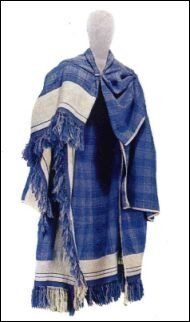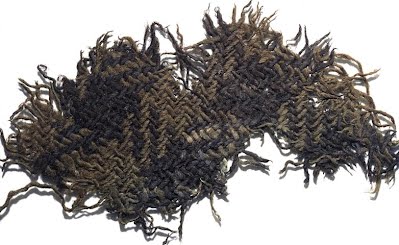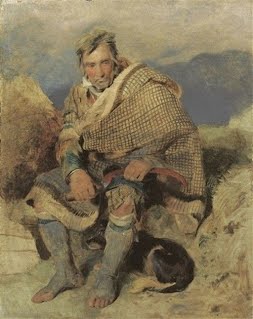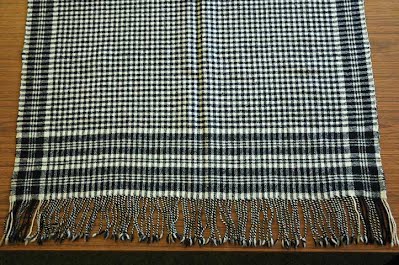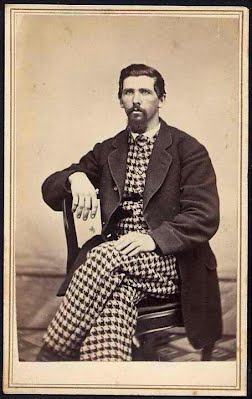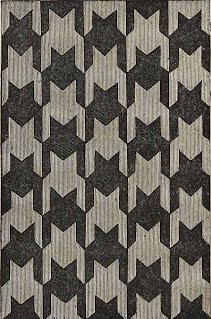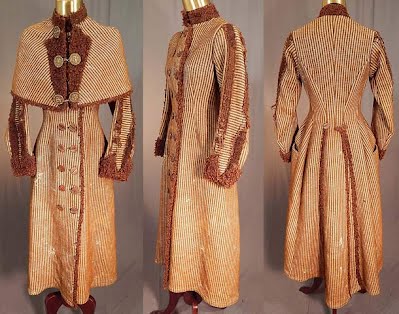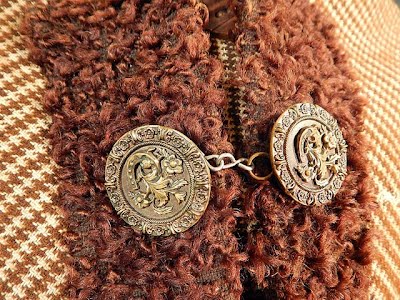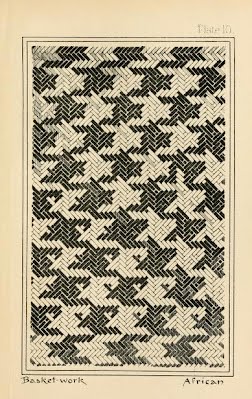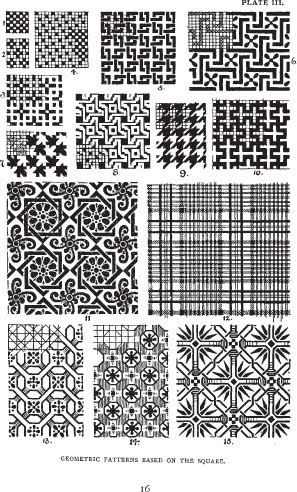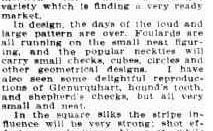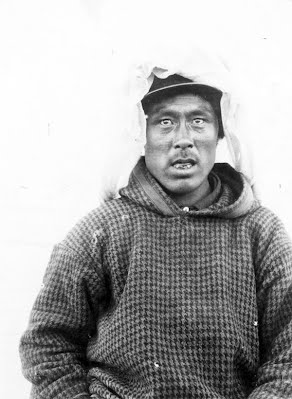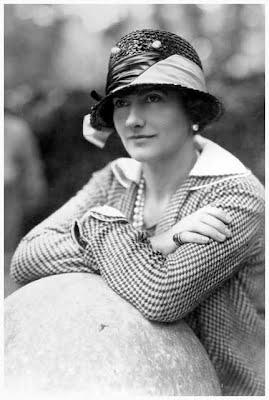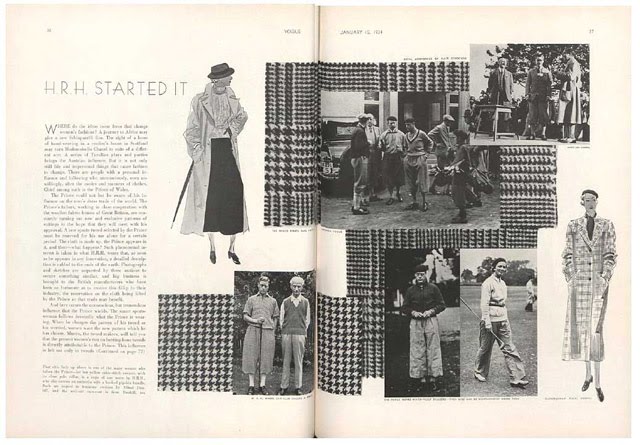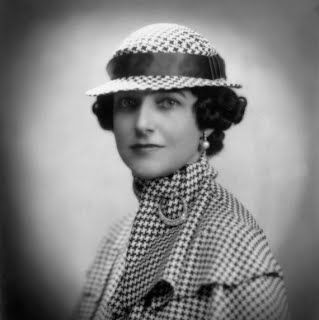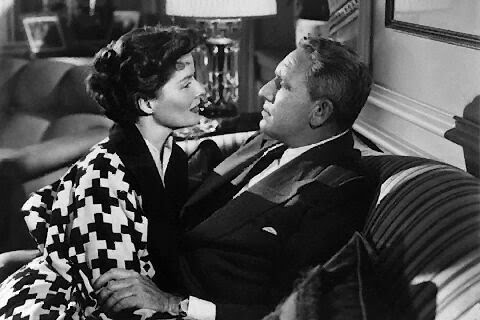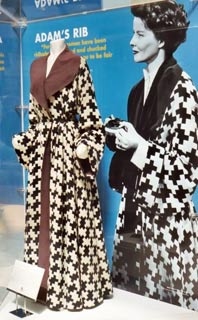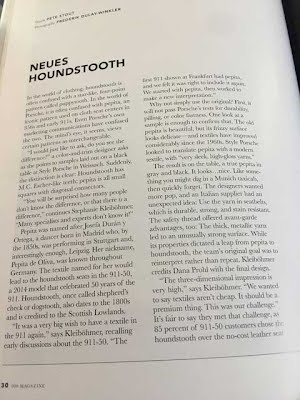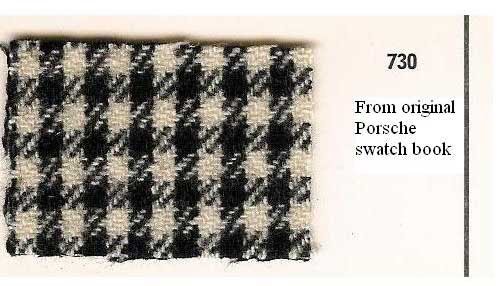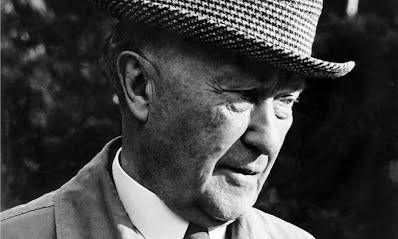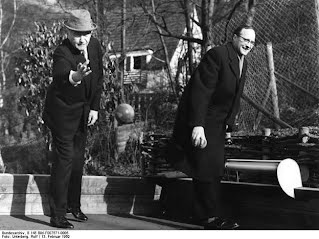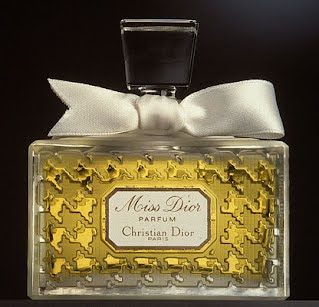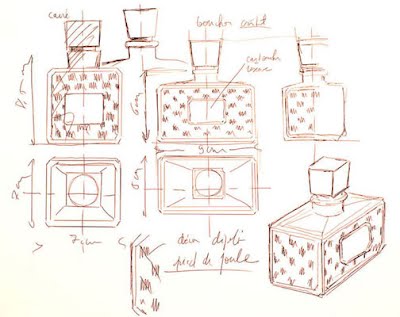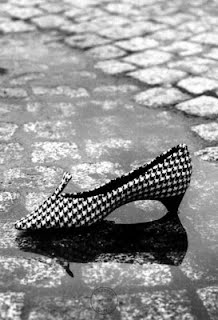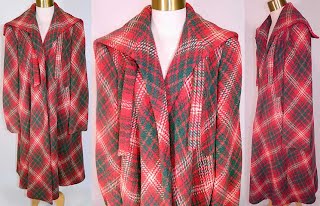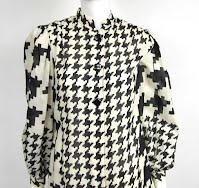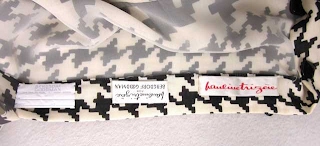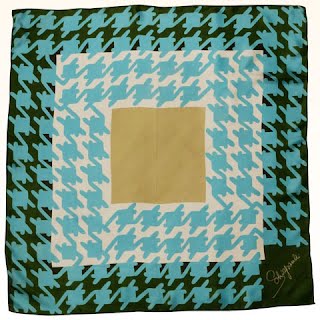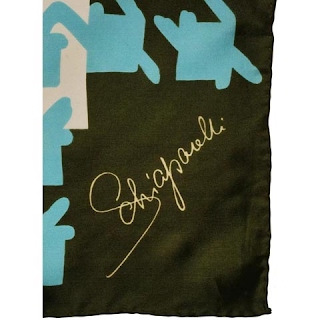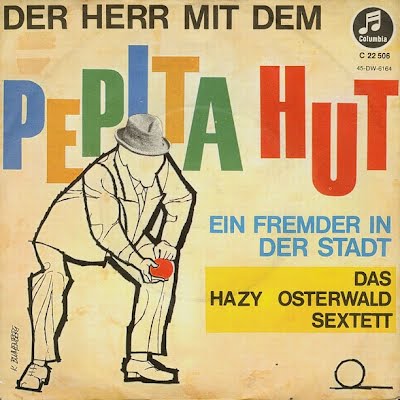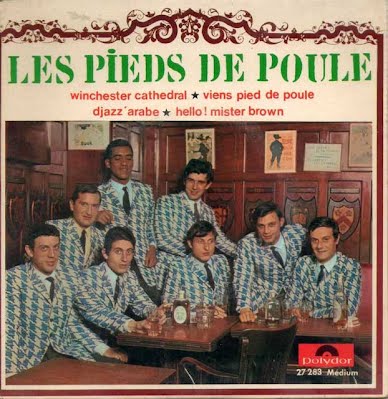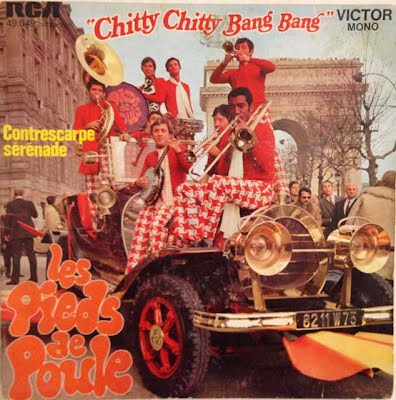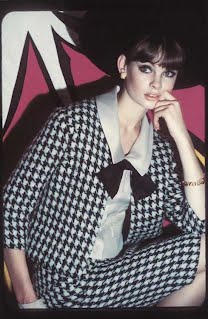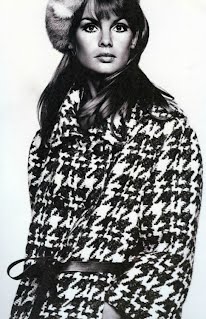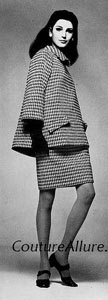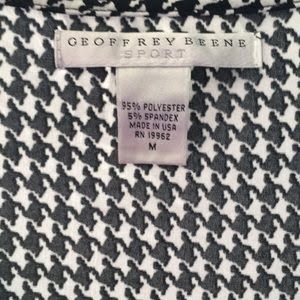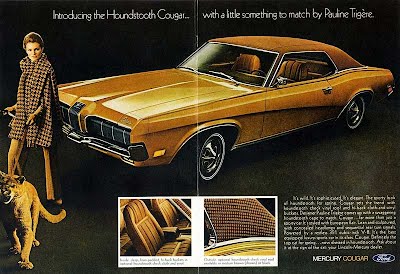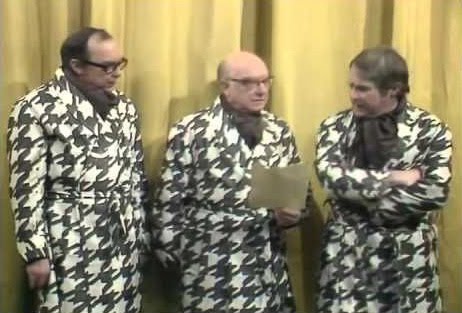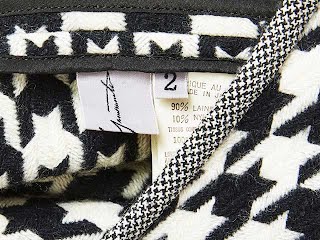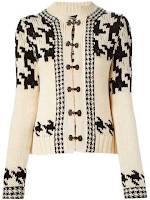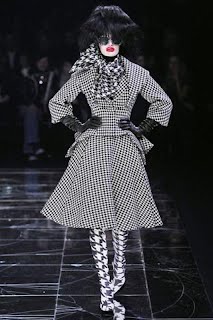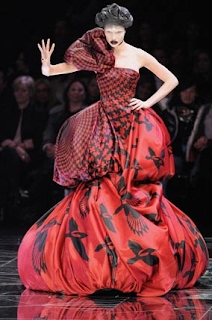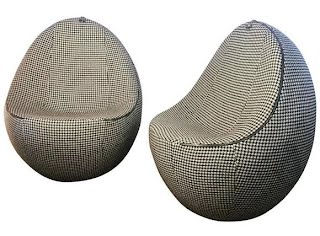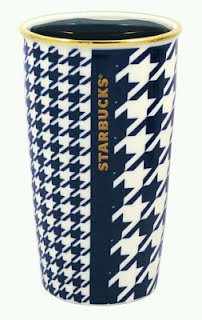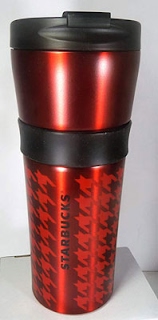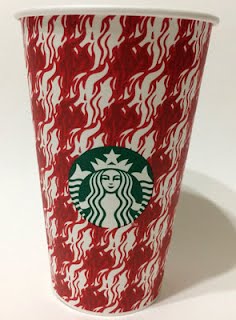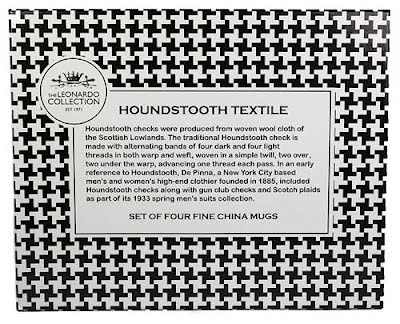A rough, potted history of houndstooth, in chronological order, and subject to much revision, albeit it is indeed of a thorough nature, and of which I can confidently assert that there is no such similar study. That said, the historical investigation (never mind other matters, such the mathematical aspects) is still ongoing. And indeed, will likely remain so for many a year, so vast is the material to survey and the remit. And seemingly as ever with houndstooth, there are problems. As such, quite what to include as a history is open to debate; houndstooth seems to delight in vagaries! Perhaps the most debatable point here is that of houndstooth’s seemingly precursor source, the shepherd's check. Although strictly this is aside, and so arguably could be omitted, such practice, to my thinking at least, omits many interesting connections. This being so, I have this decided to include. And then there are other descriptions under which houndstooth masquerades, such as dogtooth, chicken’s foot, pied de poule and many others. And then where to begin with houndstooth itself? Although the term was introduced in 1925, there are the occasional earlier instances where this is shown without the later attribution. Although houndstooth was thus not ‘intended’, and so strictly not designed as such, nonetheless these (relatively few) instances remain of interest. And then how to define houndstooth itself? Although to the tyro it may be thought to be but a single instance, it is perhaps best to regards this as of at least two core types. And then one can even build on this. The authority Loe Feijs considers this best describes a family of designs. Therefore, with such complexities as outlined above, one can only do one’s best; here is my humble offering. Thoughts, suggestions and corrections are welcomed. 360 and 100 BC, Gerum Cloak, Sweden The oldest known occurrence of houndstooth is the so-called ‘Gerum Cloak’, a garment uncovered in a Swedish peat bog in 1920, named after the nearest town, and is dated to between 360 and 100 BC. The story is told over four pages (see links). Of course, the term houndstooth is applied here retrospectively. However, to my eye at least, the houndstooth pattern is not obvious, but as this has been analysed by fabric experts (in terms of the twill) it would indeed appear to be so. http://www.mynewsdesk.com/se/pressreleases/sveriges-aeldsta-klaedesplagg-en-2000-aar-gammal-pepitarutig-mantel-97263 3 AD, Spin-patterned wool twill, Denmark Spin-patterned wool twill from Donbaek, north Jutland, Denmark, third century AD. From a reference in The Cambridge History of Western Textiles by David Jenkins, pp. 69, 96-97. Patricia Chung, p. 3, also quotes Jenkins. However, the houndstooth nature is not readily visible. 5 AD, Thorsberg Cloak, Germany A perhaps somewhat less than certain connection to houndstooth is that of what is titled the Thorsberg Cloak from 5CE, from Germany, and was discovered in a peat bog in the 1860s. This is described as of a check pattern. Reading up on this, there seem to be many other checked fabric findings of this period, and later years too. Likely this is just one of the relatively many checks of the time, not necessarily a shepherd's check, but I’ll include for the sake of thoroughness. I must admit, it’s all very convoluted and requires far more time to unravel than I am prepared to devote to the task. A good site for such historic check matters is: C. 230 AD, Falkirk Tartan The ‘Falkirk Tartan’ is a woollen cloth fragment, now in the National Museum of Scotland, in Edinburgh, described as of a simple check design, c. 230 AD. This was taken from the mouth of a pot containing a hoard of Roman coins, part of the Falkirk Hoard found on 9 August 1933 in Bell's Meadow, Falkirk, Stirlingshire, some 400 metres north of the Antonine Wall. Workmen, including Robert Wallace, were levelling a small hill in the area, removing the sand, when one of them hit a Roman jar with his spade. It broke on lifting and a hard metallic cluster covered in green mould fell out along with the remains of a piece of cloth. The piece of cloth is assumed to have closed off the mouth of the red pottery vessel. Two fragments of this cloth were well enough preserved to show the weave. The largest piece measured approximately 4" square and gives a full repeat of the design. There were also loose threads and tiny fragments from the same textile. The wool was woven in two colours - dark brown and a pale greenish-brown shade. Although both are natural shades of the fleece from early breeds of sheep e.g. Soay - the greenish-brown shade was caused, no doubt, by contact with the coins found in it. The experts (not sourced), at the time the hoard was uncovered in 1933, agreed that the wool was of fine quality. Since the pieces preserved were too small and loose to distinguish accurately, there was nothing to show which was warp and which was weft. Having stripes both in warp and weft, forming checks, it could be loosely described as a tartan, although the weave was not the same as we understand clan fabrics nowadays. The hoard was discovered some seven feet below ground in a filled in pit or ditch and must have been buried at a time of emergency, one in which the owner died, and with him the knowledge of its location. Incidentally, after cleaning, some 1,925 silver coins were identified; others having been taken from the scene by workmen suggest that the original hoard was of around 2,000 coins, making it the largest Roman coin hoard ever found in Scotland. It’s ironic to think that, in the long term, the treasure someone once hoarded away turned out not to be the money, as important as that aspect is, but the cloth used to pad it. The check has been associated with shepherds of the Border region who were encouraged to move north after the Highland Clearances. Thus, a version of the ancient Falkirk Tartan is now also known as the ‘Border’ or ‘Border Riever’ tartan, all of which complicates matters as to definitions and attributions. Kerstin Bergdalaspinnhus, a Swedish professional weaver, has examined this in relative depth (and recreated as an abstract weave), describing it as ‘a straightforward 2/2 broken-reversed twill, treadled straight’. Geoff Bailey, a Falkirk archaeologist and keeper of local history, describes it as ‘it is of a type known as weft-woven (or dog-tooth) check in woollen fabric’. The National Museum of Scotland is of a decidedly lightweight description, with ‘Woollen cloth fragment with a simple check design’. Trudi Mann and Jim McGeorge, of a Falkirk connection ‘The Falkirk cloth is certainly the earliest herring-bone designs recorded for Scotland’. For now at least, with such vagaries, pending further investigation, I refrain from describing this as houndstooth. As ever, there is a whole host of open questions: 1. Where are the (presumed) 1933 references? The Falkirk Herald reports (2016): ‘Later on Robert [Wallace] told the Herald reporter: “Some of my workmates made a rush for the coins which broke away from the main cluster but I wrapped my jacket over them and carried them to the tool shed where I put them under lock and key.” From this, it would indeed appear to have appeared in the Herald of that year. 2. Are there earlier newspaper reports than that of 1977? Somewhat curiously, references to this at the time of discovery are not to be found, although I am sure that there must be. Indeed, the term is largely ‘unofficial’, with only eight newspaper references found, the first as relatively late as 1977! Curiously, the earliest known newspaper reference is of 1977, albeit surprisingly not in Scotland as may otherwise naturally be thought, but rather oddly the US, with the Morgantown Morning Reporter Saturday, January 15, 1977! Only much later, in 1988, in the Perthshire Advertiser Tuesday 12 April 1988 p. 21, was it discussed in Scotland. The first English reference is the Liverpool Echo Monday 26 May 1997, p. 34. It is not known in Australia, France, New Zealand and the Netherlands. 3. When, and by whom was the title given? The Herald reports (2016): Along with the coins the pot also contained an intriguing little piece of cloth which is often called the ‘Falkirk Tartan’ though when exactly it was given this name is not clear. Certainly, it was not even mentioned at the time of the discovery or for many years afterwards. As detailed above, the first known reference is of 1977, oddly in the US! As ever, thoughts on any of the above are welcomed. Falkirk Tartan Fragment 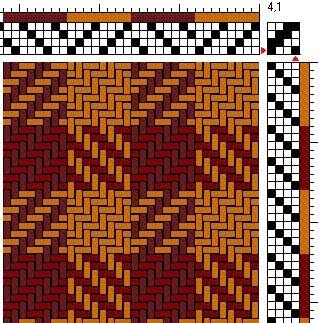 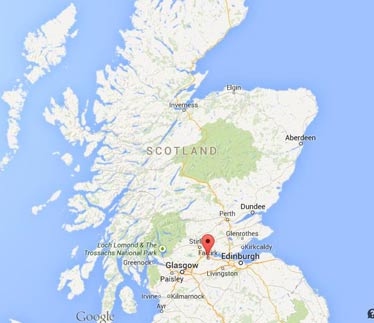 Recreation as a weave, by Kerstin Bergdalaspinnhus, left, Falkirk on map References National Museum of Scotland https://www.nms.ac.uk/explore-our-collections/collection-search-results/?item_id=134896 Kerstin Bergdalaspinnhus https://oddweavings.blogspot.com/2015/05/the-falkirk-tartan.html Trudi Mann and Jim McGeorge http://www.caithness.org/caithnessfieldclub/bulletins/1997/falkirk_tartan.htm Minor Falkirk Tartan reference in an piece on ‘The Oldest Tartans in (pre) History’ https://usakilts.com/blog/the-oldest-tartans.html The Falkirk Herald. A modern day (2011 and 2016) look back on the discovery and Robert Wallace’s part in it. https://www.falkirkherald.co.uk/news/falkirk-tartan-is-the-oldest-in-britain-dating-back-to-roman-times-1-3994264 https://www.falkirkherald.co.uk/lifestyle/nostalgia/falkirk-s-greatest-roman-discovery-1-4327903 C. 16th Century tea jar, after Sen no Rikyu, Japan A purported houndstooth design is of a famous 16th century tea jar from Japan, the rikyu-kando (houndstooth), said to have been named after the famous tea master, Sen no Rikyu (1522-1591), the tea master that perfected the austere tea practice known as wabi-cha that continues to this day. The Japanese tea ceremony is also called the Way of Tea, is a Japanese cultural activity involving the ceremonial preparation and presentation of matcha (抹茶), powdered green tea. The jar is registered to National Treasure, important cultural assets at Nezu museum in Tokyo. However, the image I have from the museum in not entirely satisfactory, in that a houndstooth design is. for me at least, this is not definitive. Indeed, far from it. However, this sighting was brought to my attention by Yoshiaki Araki, who found it catalogued as such, as well as another reference below I have found which seemingly confirms a houndstooth nature. As such, with reservation, I will thus take this at face value as a houndstooth design. References: http://www.nezu-muse.or.jp/en/collection/detail.php?id=40091 1800s? It is often said, with generally no attribution, that houndstooth checks may have appeared in the Scottish Lowlands of the 1800s: First created in the 1800s in the Scottish lowlands (not sourced) Wikipedia gives the following quote and source, albeit not dated (not seen): … houndstooth checks may have originated in woven wool cloth of the Scottish Lowlands, but are now used in many other materials. Dunbar, John Telfer. The Costume of Scotland, London: Batsford, 1984. This is apparently the only definitive reference, or would appear to be so. In general, similar designs, such as shepherd’s check, may instead being referred to. Jonny Beardsall is more exact as to the place, although his quote is not sourced: http://www.jonnybeardsall.com/?product=swinsty-cap Houndstooth originated in the wool cloth of the Scottish lowlands and this was woven in Hawick in the Borders. Beardsall is a hat designer, from England, and so it is doubtful if this is his own research. Lilian M Raji gives https://oureverydaylife.com/the-history-of-houndstooth-12214429.html The black and white abstract checkerboard pattern with a vague resemblance to a chicken-foot print -- known in French as the pied de poule and in English as houndstooth -- first appeared in the 1800s in the Scottish lowlands. Then, it was called Shepherd's check or Dogtooth, and was mostly used on woven wool cloth outerwear for sheepherders. Today, the duo-tone pattern can be found on everything from tweed jackets to designer stiletto heels. In the 1920s, Scottish clans commandeered the notably original check from the sheepherders [sic] to claim for their tartan designs. And while Scottish clans are notoriously hostile about outsiders wearing the patterns of their tartans, houndstooth is the neutral Switzerland of the tartan world. The check pattern was never officially registered by any one clan, as is the tradition when a clan chooses a tartan to represent them. However, this is not sourced. Likely this is not original research on Raji's part. The whole situation is infuriatingly vague in the extreme. Frequently, the above Wikipedia quote is given by others without the all important proviso word ‘may’, as if its appearance is for certain. Does anyone know more on all this in general? As alluded to elsewhere, without exact pictures, with so many variations, this is not exactly ideal. For what is worth, below I show a painting by Sir Edwin Henry Landseer 1802–1873 , ‘A Highland Shepherd’ (not dated), which is sometimes associated with houndstooth claims of this period. It is said that Landseer first visited the Scottish Highlands in 1824, returning many times. However, it is clearly not houndstooth. 1812, Shepherd’s Plaid (Shepherd's Check) Caledonian Mercury Monday 30 March 1812 Ad and notice p. 3 (*shepherd’s plaid) c. 1813 Shepherd’s Plaid, from Heriot-Watt University Textile Collection A 200-year-old shepherd's plaid from the Heriot-Watt University Textile Collection, Edinburgh, Scotland. Of note (and indeed initial concern!) is the near new-like condition, but this is misleading; it is indeed 200-years-old! These shawls were originally worn by shepherds in the Scottish Borders, and the traditional black and white check design was the original inspiration for tweed. Shepherd's Plaid from the Heriot-Watt University Textile Collection1829, Shepherd’s Check Northern Whig Saturday 23 September 1837 p. 3 Article (*shepherds’ check) The first reference to Shepherd's Check in print. 1834, Charles Dickens in The Boarding House He wore shepherd's-plaid inexpressibles, and used to look under all the ladies' bonnets as he walked along the streets. His manners and appearance reminded one of Orson. ‘Inexpressibles’ here is an archaic term for trousers, of which in Dickens’ time were not talked about in polite company! More exactly, these were very tight, usually knitted of silk, trousers - almost like today’s women’s leggings, designed to show off a gentleman’s muscular legs to best advantage. 1835, Shepherd’s Tartan Inverness Courier Wednesday 29 April 1835 Article p. 3 (*shepherd tartan) 1839, Border Tartan (Shepherd's Check) Cumberland Pacquet, and Ware's Whitehaven Advertiser Tuesday 7 May 1839 Article p. 3 The first reference to Border Tartan in print. Terminology here is confusing. 1851, Border Check (Shepherds Check) Illustrated London News Saturday 11 October 1851 Article p. 22 C. 1861-1865 Carte de Visite A most interesting historical instance of houndstooth is shown on a carte de visite, dated from the American Civil War (1861 to 1865), albeit the reference is not sourced, and is simply titled on Linda Powell’s Pinterest page (not on the photo itself, which seemingly bears no inscription) ‘Civil war era houndstooth’. The carte de visite, a French term, is a visiting card, abbreviated CdV, and was a type of small photograph which spread throughout Europe and then quickly to America and the rest of the world. Of course, at the time it was not known as houndstooth (it only becoming so titled in 1925). Does anyone know more as to the background? Were such suits a rarity or relatively common? It is likely the former, as this is the only known instance. Or indeed any other informed comment. Speculating, possibly the photo was taken in Baltimore. Another photo, seemingly showing the same man, but with a moustache and wearing other clothes is described: ‘A Civil War era portait (sic) of a man wearing riding boots and holding a broad brimmed hat, taken by Fischer & Bro. of Baltimore, Maryland. He is, unfortunately, unidentified, but his boots have some distinctive markings, the most visible of which are two five pointed stars (at left) - I'm not sure what, if anything, it is that these may signify.’ The image is one of many such pictures from the genre. It is most unlikely that the picture originates with her (and furthermore it appears elsewhere on the web, and so she may, in turn, have borrowed it), but has been taken from some specialised CdV page. Upon contacting her from more details, she did not respond. 1864, Prince of Wales Check The Argus (Melbourne, Vic.) Monday 11 January 1864 p. 2 Advert The first reference to Prince of Wales Check in print. 1868, Grammar of Ornament by Owen Jones, p. 15. Plaited Straw from the Sandwich Islands (Hawaii). Note that the diagram is not indicative of a plaited straw, being of a line diagram drawing. Does anyone know more on this? Is there an actual photo of a plaited straw instance? I have not been able to find one, of the period, or subsequently. As an aside, curious about how the islands acquired the somewhat odd name, I see that Wikipedia gives ‘John Montagu, 4th Earl of Sandwich invented the sandwich. He lived from 1718 to 1792 and was First Lord of the Admiralty. Captain James Cook discovered a group of islands in the Pacific and named them after him. The Sandwich Islands belong to Hawaii today’. Note that Lockwood and Macmillan almost certainly also briefly (two lines) refer to this instance although their illustration, in stark black and white ink, they give does not correspond to that of Jones, being proportionally different, although interesting in its own right, not seen before. Plaited Straw 1869, Glen Urquhart Check London Echo Monday, April 5, 1869. The first reference to Glen Urquhart Check in print. C. 1880s, Victorian Brown Mohair Houndstooth Wool Winter Sport Ice Skating Coat and Cape A most interesting, one-off finding is of what is described as a 1880s houndstooth ice skating coat and cape. However, matters of provenance here are taken at face value, from the description alone, on eBay, although this would appear indeed to be so from the nature of the seller, of vintage era clothing. Further, I am not entirely convinced that this is indeed houndstooth. As detailed above, the term houndstooth is applied most liberally at times! Whatever, were such checked coats and capes popular of the day? Three views of coat and cape, left, and cape detail, right References: http://vi.vipr.ebaydesc.com/ws/eBayISAPI.dll?ViewItemDescV4&item=311703195283&t=0&tid=10&category=175783&seller=1860-1960&excSoj=1&excTrk=1&lsite=0&ittenable=false&domain=ebay.com&descgauge=1&cspheader=1&oneClk=1&secureDesc=0 1884, Gun Club Check Western Daily Press Wednesday 17 December 1884 p. 3 The first reference to Gun Club Check in print. C. 1888, Basketwork, Africa, in the book Ornamental Design by Lewis F. Day As seen in Ornamental Design, Embracing [1] The Anatomy of Pattern, [2] The Planning of Ornament, [3] The Application of Ornament by Lewis F. Day, first edition, 1888. As such, Day gives next to no background detail of this basketwork houndstooth from Africa, with the rather sparse caption ‘basket-work, African’. No other detail is given elsewhere in the book. The date stated by myself is of the publication of the book, to at least give an indication as to a year; possibly, the artefact is much earlier. A search (February 2019) for further instances (at least of an initial nature) from Africa of this date proved fruitless (and indeed in the wider sense). Interestingly, it can be seen that this is an idealised drawing, rather than as an artefact (as with the Sandwich Island instance). However, knowing of Day’s reputation, there can be little doubt that this indeed originated as an artefact. As ever, does anyone know more on this, and indeed, of houndstooth in basketwork? 1893, Chicken’s Foot Western Mail (Perth, WA) Saturday 5 August 1893 p. 49 Article The first reference to chicken's foot in print. 1894, Pied de Poule Le Journal 16 June 1894 The first reference to Pied de Poule in print. 1897, Plate III from Stephenson and Suddards' A Text Book Dealing With Ornamental Design For Woven Fabrics Houndstooth as a (black and white) tessellation from Plate III of C. Stephenson and F. Suddards' book A Text Book Dealing With Ornamental Design For Woven Fabrics. Note that although I date this as 1897, there is a caveat to this. The book has four editions, with the first of 1897, and fourth, 1923, of which I have only seen the fourth. Presumably, this plate is also in the 1897 edition, and so I have dated accordingly. Of course, this is not described as houndstooth as it predates the term, and is interesting as an instance of how the design can arise. 1907, Dog Tooth Examiner (Launceston, Tas.) Saturday 29 June 1907 p. 9 Advert The first reference to dogtooth in print. 1920s Said to be when Scottish clans began to use. Source? 1925, Houndstooth The Herald (Melbourne, Vic.) Saturday 9 May 1925 p. 16 Article (*hound’s tooth) The first reference to houndstooth in print, in an Australian newspaper, albeit of an English story... Clipping1926, Inuk Man in a Houndstooth Parka Details of this sighting, from the Canada Library and Archives, as most sparse indeed, with written in white pencil below the photograph, ‘Native type’ and is simply captioned ‘Inuk man in a houndstooth parka. July, 1926’. Other detail given is that the photo was taken at Chesterfield Inlet (Igluligaarjuk), Nunavut. Still, at least we have a definitive date and place. With such a lack of detail, and being unaware if the term parka was both appropriate and correctly attributed/dated, I investigated further. From Wikipedia: A parka or anorak is a type of coat with a hood, often lined with fur or faux fur. The Caribou Inuit invented this kind of garment, originally made from caribou or seal skin, for hunting and kayaking in the frigid Arctic. Some Inuit anoraks require regular coating with fish oil to retain their water resistance. The word anorak comes from the Greenlandic (Kalaallisut) word annoraaq. It did not appear in English until 1924; an early definition is "a beaded item worn by Greenland women or brides in the 1930s". In the early 1950s it was made from nylon, but changed to poplin by 1959, when it was featured in Vogue magazine as a fashion item. In 1984, The Observer used the term to refer to the type of people who wore it and subsequently, in the United Kingdom, it is sometimes used as a mildly derogatory term. Credit: L.T. Burwash / Dept. of Indian and Northern Affairs collection / Library and Archives Canada / e006609539
1929 Coco Chanel Gabrielle Bonheur ‘Coco’ Chanel (1883 – 1971) was a top French fashion designer and a business woman. She was the founder and namesake of the Chanel brand. Chanel was credited in the post-World War I era with liberating women from the constraints of the 'corseted silhouette' and popularizing a sporty, casual chic as the feminine standard of style. Houndstooth is said to be a favourite of Chanel, although the quote is not sourced. At an uncertain date, Chanel produced houndstooth suits. Chanel, pictured, in a houndstooth jacket, in Vogue, at Fauborg, St Honore, Paris. Photo by Alex Stewart ‘Sasha’ 1929. 1932, Northumberland Tartan (Shepherd's Check) Yorkshire Post and Leeds Intelligencer Friday 6 April 1923 Article p. 7 The first reference to Northumberland Tartan in print. 1933, De Pinna, Men’s Shop In an seemingly early reference to houndstooth, De Pinna, primarily a men’s shop located on New York City’s Fifth Avenue, US included houndstooth checks along with gun club checks and Scotch plaids as part of its 1933 spring men's suits collection. However, as detailed elsewhere, I have concerns about the date from The New Yorker references from Google Books, and so this is thus with reservation. Further, I have not seen this article. Nor have I seen any picture. Does anyone have further details? Some background details on De Pinna: Founded in 1885, De Pinna also sold menswear-inspired clothing for women that was finely tailored. In the early 1950s De Pinna was bought by the Washington, DC store Julius Garfinckle & Co. The stores closed in 1969. Clipping from The New Yorker, 1933?1933, Swagger Suits and Coats In Australia, ‘swagger’ suits and coats with the chicken's foot design became all the rage, especially seen at the races, before then quickly disappearing into obscurity by the end of the decade. The term was also known in the US. 1934, Vogue Of interest is an article titled ‘H.R.H started it’ in the well-known fashion magazine Vogue, January 15, 1934, pp. 16-17, and 72, although nowhere in the article is houndstooth mentioned! Rather, this concerns the H.R.H. Prince of Wales sporting and hence made popular the houndstooth-related Gun Club Check and Glen Urquhart Check. However, the entire article is not the easiest to analyse! As such, it is not widely available, that is not unless you want to spend an amazing $1575 accessing the Vogue archive! However, it is partly reproduced in Priscilla Chung’s informative (all round) piece (the article seemingly continues on p. 72, but this is not shown) : https://www.yumpu.com/en/document/view/3800979/houndstooth-imprint-nyc See pp. 10-11. However, even this has drawbacks, in that one has to use the enlargement facility to readily read the text and view the images and then scroll, which in itself has inconveniences. Be all as it may, at least the main gist of the story is presumed apparent. Broadly, it's a piece on the Duke of Windsor, and his fashion design favouring. Of note is that Glen Urquhart check and Gun Club check are stated in the accompanying picture captions (although not in the text itself): ‘H.R.H makes Gun-Club Checks (illegible)’ ‘Glen Urquhart Plaid (illegible. Dunhill?)’ Note that both terms are not in any sense ‘new’. Gun club check came into being in 1874, and Glen Urquhart in 1869, so both were already established. Accompanying the article are numerous images. As such, this is one of the more informative and interesting articles. In general, such discussions are perhaps, surprisingly, few and far between. Certainly, this must the one, if not the, first such substantial treatments in relative terms, even of just three pages. As an aside on this, does anyone know of other earlier such pieces? 'H.R.H Started It', Vogue Article1937/39, Christian Dior, Café Anglais design (a houndstooth wool dress) For once, with a plethora of print sources, the famed fashion designer Christian Dior’s references can confidently be asserted as more accurate than most here. Simply stated, there are two distinct dates of significance concerning Dior and houndstooth, of 1937/39 (of a houndstooth wool dress) and 1950 (where houndstooth was used on the Miss Dior perfume flacon). For the sake of clarity, I thus discuss under separate entries. Christian Dior (1905 –1957) was a French fashion designer, best known as the founder of one of the world's top fashion houses. Before becoming world famous, Dior was employed by couturier Robert Piguet as a ‘modeliste’ along with Pierre Balmain. His ‘Café Anglais’ design (a houndstooth wool dress with a tight-fitting top and full skirt) catches the attention of the fashion press including Carmel Snow, editor of Harper’s Bazaar in the US. However, I have not been able to find a picture of the dress. Does anyone know of one? As an aside, Christian Dior’s first visit to London, in 1927, set the tone for his lifelong love affair with Britain. Ostensibly in the capital to improve his English, the then 21-year-old Dior really took that trip in to catch the first night of a ballet, designed and composed by two of his bohemian friends. More importantly, he fell for England in a big way, forever enjoying ‘the same sensations of happiness and personal liberty I experienced on that first trip. I adore the English, dressed not only in the tweeds, but also…’. Likely from this visit he saw houndstooth somewhere as clothing, and finding favour with it later used this extensively throughout his life. Further to this initial reference, also see extensive entries for 1950, of Dior’s Miss Dior perfume, and 1959, a Roger Vivier shoe. 1939, Basil Rathbone as Sherlock Holmes in The Hound of the Baskervilles A notable use of houndstooth in popular culture was in film by Basil Rathbone (1892-1967) in Sir Arthur Conan Doyle's fictional Sherlock Holmes stories, released between 1939 and 1946, the first being The Hound of the Baskervilles, in which he wore a houndstooth deerstalker cap (and a related glen Urquhart cape?) Rathbone wore the deerstalker in his first two films, which were by Fox and set in the Victorian Era. Universal made the rest of the series, made them contemporary and dropped the deerstalker. Because of the cap's popular association with Sherlock Holmes, it has become stereotypical headgear for a detective, especially in comical drawings or cartoons along with farcical plays and films. However, there is a most interesting back story to all this; Holmes is never actually described as wearing a deerstalker by name in Arthur Conan Doyle's stories! However, most notably in ‘The Adventure of Silver Blaze’, the narrator, Doctor Watson, describes him as wearing ‘his ear-flapped travelling cap’, and in ‘The Boscombe Valley Mystery’, as wearing a ‘close-fitting cloth cap’. As the deerstalker is the most typical cap of the period matching both descriptions, it is not surprising that the original illustrations for the stories by Sidney Paget in Great Britain, and Frederic Dorr Steele in the United States, along with other illustrators of the period, depicted Holmes as a ‘deerstalker man’, which then became the popular perception of him. In fact, Paget last drew the deerstalker in 1903. Holmes would not wear such a cap in the pages of The Strand for eighteen years, when Frank Wiles drew three such pictures for the final story, 'Shoscombe Old Place'. But ask what hat Sherlock Holmes should wear, and the answer is ‘a deerstalker’. We owe that to Sidney Paget. Steele based his concept of Holmes mainly on photographs of the actor William Gillette, who had become hugely popular as a portrayer of Holmes during the first third of the 20th century. Gillette had worn a deerstalker in his stage play which first ran in 1899. It was left to Steele's influential drawings to popularise Holmes as wearing a deerstalker so that the cap became synonymous with the detective. References and web pages of interest: http://www.sherlockian-sherlock.com/sherlock-holmes-deerstalker-hat.php https://decider.com/2015/09/06/the-essential-sherlock-holmes-on-streaming/ 1940s, Dorothy Draper Here, although credited as a houndstooth, this is a variety type. 1949, Actor Katharine Hepburn in a houndstooth robe ‘variation’ On the premise of variations, the US actor Katharine Hepburn in the 1949 American romantic comedy film Adam’s Rib sports what is said to be a ‘houndstooth robe’. However, it can clearly be seen not be of the standard design, nor of a related minor variation. In such circumstances, I normally put such seemingly false accounts down to the author’s ignorance, in that they are confusing houndstooth, perhaps due to the (obvious) jagged nature here, or of a black and white colouring. However, on more than this single instance, I have seen this particular design described as houndstooth, so much so that it may indeed be an element of truth to it. That said, the authority Loe Feijs, who has analysed minimum and infinite houndstooth does not show this in his various researches. An obvious open question - is this indeed a ‘permissible’ houndstooth variation or incorrect attribution? Katharine Hepburn (with Spencer Tracy), left; Museum exhibit, right 1949–1950+?, Porsche 356 Car https://www.porsche.com/museum/en/archiv/ On occasion, Porsche enthusiasts have indeed written on this, and in some detail too, using images from the archive, of which the following is based. That said, some are hopelessly confused as to the correct terminology…. Jeff Peek, of the US, writing on the forum of the Hagerty.com site, ‘for people who love cars’ wrote an extensive (seemingly original) piece, and gives an excellent history. However, matters are confused as to what he considers pepita/houndstooth to be, with other alternative terms used. Here, he uses, and illustrates, the term ‘Vichy’, which is simply wrong. Then another alternative offered is ‘Shepherd’s Check’. Possibly some of this confusion arises from a quote taken by the Recaro automotive seat company, but if so I cannot find it on their website…. It’s simply impractical to unravel all this muddle. Be all as it may, the following quote is interesting: Although many assume that Porsche first used Houndstooth on the seats of the 1949–50 Porsche 356, that upholstery pattern was, in fact, another design entirely. “In colloquial English, the word ‘Houndstooth’ might be used regularly when ‘Pepita’ would actually be the right description of the pattern,” says Ulrich Andree, Director Global Communications at Adient Communications, which includes Recaro. “The actual Houndstooth pattern was never used in an official Porsche seat or a Recaro seat made for Porsche.” According to Recaro, when Reutter (Stuttgarter Karosseriewerk Reutter) started production of the Porsche 356 seats, it offered a number of optional seat covers, including one that carried a black-and-white pattern. The design was neither Houndstooth nor Pepita but a unique cloth design, and the fabric was made of nylon. Recaro, founded in 1963 by the Reutter family, first produced Pepita pattern for customers in December of that same year. The first Porsches to use the Pepita design were late 356C models. They were followed by the Porsche 901/911 and Porsche 912. This at least gives the earliest usage, namely that of 1949 (one year after the founding), of the generally accepted design of pepita/houndstooth, call it what you will. https://www.hagerty.com/articles-videos/articles/2018/06/22/porsche-houndstooth-seats-exposed There is also a most interesting posting on ‘Rennlist’, described as ‘The Porsche Enthusiast Site’, from the Porsche ‘000 magazine no. 1’ as regards pepita: https://rennlist.com/forums/991-gt3-gt3rs-and-911r/1046814-houndstooth-pepita-factoid-2.html The magazine background, from their website: “This is the magazine I’ve always wanted to build,” says Editor Pete Stout, who teamed with fellow car fanatic/editor Alex Palevsky and designer Justin Page to create 000 Magazine, a quarterly journal focused on Porsche. Its unusual name—spoken as “Triple Zero”—is a reference to Porsche’s three-digit model type numerology. It’s also a promise to explore the marque from its origins forward, without skimping on pages or possibilities. To muddy the waters even more (but are you surprised?) Lakewell.com (a Belgium concern), of classic car interiors, gives a much later (rightly or wrongly) history. Perhaps earlier instances were disregarded; who knows? https://www.lakewell.com/en/general/fabrics/porsche-pepita-houndstooth-fabrics Make of all this muddle what you will…. 000 Magazine, left, and sample from original swatch book, right C. 1950s, Konrad Adenauer, Chancellor of the Federal Republic of Germany Konrad Adenauer (1876 – 1967) who served as the first Chancellor of the Federal Republic of Germany (West Germany) from 1949 to 1963 very much made houndstooth a trademark of his (seemingly like Bear Bryant years later). Upon following a trend in post-war Germany in the early 1950s, where houndstooth became particularly popular on suits, hats, ties and costumes, Adenauer sported it himself on a hat mainly on Italy holidays on Lake Como, particularly when playing bocchia (boccia is a precision ball sport, similar to bocce, and related to bowls and pétanque). Later, having in effect popularised it so, in 1961 a song by the Hazy Osterwald Sextett was dedicated to him and the hat, see below of 1961. Konrad Adenauer with hat, left, playing bochia, right 1950, 'Patons 61', Knitwear Hat Design Although details here are decidedly sketchy, with the context still not fully unravelled, this photo was published in an wool and yarn context, in Patons 61, Hats by Beehive of January 1950, with instructions as to how to knit: Further, a Breton (or Bretonne) is a woman's hat with a round crown and a deep brim that is turned upwards all the way round, exposing the face. Sometimes the hat has a domed crown. Typically it is worn tilted to the back of the head. 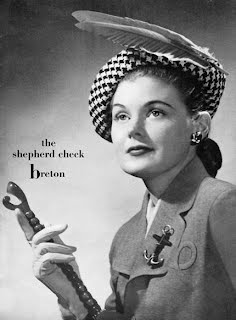 Patons 61 1950, Christian Dior, Miss Dior Perfume First, there are various misattributions as to the date of the Miss Dior perfumery instigation of houndstooth. I have seen entries for 1930s and 1947 in particular, when Christian Dior’s ‘New Look’ took the world by storm. However, although the Miss Dior range was indeed introduced in 1947, this was not contemporary with the use of houndstooth, as it was not until 1950 that this appeared. As to the naming, Dior took advantage of the launch of his first collection to introduce the new fragrance. But until that time it had no name yet. That’s when the couturier’s sister Catherine Dior walked into the Dior Couture boutique, and, as she came down the stairs, Dior’s muse Mitzah Bricard exclaimed: ‘Here’s Miss Dior!’. Of a sudden, Christian Dior replied: ‘Miss Dior! That’s my perfume!’. He imagined Miss Dior as the very soul of his dresses. This iconic bottle, like any emblematic flacon, holds many key elements. Houndstooth, bow tie and ribbon, and the English typography: these are codes that have dressed Miss Dior perfume since its creation. Pleasingly, some concept sketches have been preserved, in which the French term for houndstooth, pied de poule, is used. As can be seen, houndstooth was used for both the flacon, as an engraving, and packaging. Subsequently, Dior then used houndstooth extensively in fashion products consistently throughout the years up to the present day. Further to this reference, also see extensive entries for 1937/39, of a Dior Café Anglais dress design, and 1959, a Dior Roger Vivier shoe. Miss Dior Perfume by Christian Dior, left, and Miss Dior Perfume concept sketch, right 1951, The Catcher in the Rye by J. D. Salinger References are made to houndstooth in the famed book The Catcher in the Rye by J. D. Salinger, of 1951. At the beginning of Chapter 6, Holden says of Stradlater, who has just returned from his date with Jane Gallagher: 1959, Roger Vivier, Stiletto Shoe for Christian Dior
Late 1950s?, Pauline Trigère Pauline Trigère (1908 – 2002) was a Franco-American couturière. Her award-winning styles reached their height of popularity in the United States during the 1950s and 1960s. As an interesting aside, in 1961, she was the first major designer to ever send an African American model - Beverly Valdes - down the runway. Unafraid of antagonizing patrons, Trigère said: “[w]e only lost one customer, in Birmingham, Alabama. We didn’t miss her.” Aside from her work in fashion, she was commissioned to design a special edition trim package for a car, now known as the “Houndstooth” Cougar; see the entry under 1970. Pauline Trigère, left, jackets, middle, jacket, right label C. 1960s, Silk Scarf by Elsa Schiaparelli 1960s?, Audrey Hepburn Said to be a favourite of Audrey Hepburn, below, the famous actor, although the quote is not sourced. Audrey Hepburn 1961, Hazy Osterwald Sextett In 1961 the Hazy Osterwald Sextett released the song ‘Der Herr Mit Dem Pepita Hut’ (The Man in the Pepita Hat) in reference to the German Chancellor Konrad Adenauer’s adopting of it on his vacation in Italy where he enjoyed playing boccia (see above). As can be seen, the cover reflects this, focusing on Adenauer’s pepita hat, along with his boccia playing. The song can be heard at: https://www.youtube.com/watch?v=-2TFXNbZ7Jc Some background on the Sextett: Hazy Osterwald born Rolf Erich Osterwalder (1922 - 2012 ) was a Swiss *schlager singer and orchestra leader and met with great success in the genre. As a student, Hazy Osterwald discovered jazz in the 1930s. He played the piano, trumpet and vibes in Swiss bands. In 1949 he founded the ‘Hazy Osterwald Sextett’. At the height of his career in 1970, Osterwald had his own record publishing company and a number of nightclubs (Hazyland) in Switzerland, which he had to dispose of with the rise of discotheques. They became the official band at the 1972 Summer Olympics in Munich and the 1976 Winter Olympics in Innsbruck but also in numerous TV broadcasts. He toured until 1979 under the name Hazy Osterwald Jetset. Until 1984 he then took a break and then acted as ‘Hazy Osterwald and the Entertainers’ in the jazz genre. * For those unaware of what a schlager music is (as I was upon finding this instance of an application to houndstooth/pepita), Schlager music is a style of popular music which is generally a catchy instrumental accompaniment to vocal pieces of pop music with simple, happy-go-lucky, and often sentimental lyrics. It is prevalent in Central and Northern Europe, and Southeast Europe (in particular Germany). In the United States, it is also known as 'entertainer music' or 'German hit mix'. c. 1963, David Jones The Australian upmarket clothing chain store David Jones (colloquially known as DJs), founded in 1838 (and is claimed to be the oldest continuously operating department store in the world still trading under its original name), first used a houndstooth pattern c. 1963 as part of its corporate logo (and has done so for subsequent years, to the present day) although the story behind its instigation is disputed. Following research by Helen O’Neill, in a book celebrating the 175th anniversary, she discovered that the origins of the pattern could stretch back to the 1950s, when David and Charles Jones, the two great-grandsons of the store’s eponymous founder, pondered a suitable paper to wrap up the retailer’s products. Charles would claim the brainwave struck one morning as he walked into his mother’s dressing room and spotted Christian Dior’s Miss Dior perfume. The packing of that scent bottle combined the Dior logo over a houndstooth pattern. Charles asked a designer to enlarge the graphics background, with the pattern making its store debut in around 1963. (The earliest documented instance I have found is of 1965). However, there is a rival claim, by Geoffrey Lee, a photographer who spent many years snapping the retailer’s models has claimed he submitted a houndstooth design, in response to a request by DJs for new logo ideas. The jury is out…. Be all as it may, the branding — a black-on-white houndstooth pattern — is one of the most recognized corporate identities in Australia, and is widely used; every Australian is familiar with it (but not to non-natives; I must admit I’d never heard of the store before researching this!). A government-sponsored panel judged it in 2006 as one of Australia's top ten favourite trademarks. The origin of this motif is due to the store founder's intention not to use the name on its packaging; the store would be so well known that everyone should recognize it simply by this motif. Oddly, though, it is not mentioned on the company's ‘Story of David Jones page’! Further, the design is not just used as a logo but on a whole host of its in-store goods and has featured on everything from the bags to the garments draped over supermodels like Jessica Gomes and Megan Gale. 1965, Paul ‘Bear’ Bryant, US Football Coach Paul William "Bear" Bryant (1913 – 1983) was an famed American college football player and head coach of the University of Alabama football team from 1958-1982 (colloquially referred to as the Crimson Tide, in relation to their team colour), which met with great success in his day. Subsequently, in c. 1965, he became well-known for sporting a houndstooth hat at games, hence this inclusion. After a distinguished career, in 1988, he was honored with a museum in his name, the Paul W. Bryant Museum. Perhaps somewhat surprisingly, there is next to no discussion on the houndstooth hat there! At some point, albeit exactly when is not entirely clear with conflicting stories, Bryant became associated with houndstooth in the form of a fedora hat. Three differnt people are said to have given him the hat: Sonny Warbler, Weeb Ewbank and Mell Allen (detilied below). Further controversy is caused by if this indeed strictly houndstooth, or a variant, such as shepherd’s check, or indeed other check pattern. And yet more controversy, with terminology, of plaid, and the lack of knowledge as to specifics, with casual commentators using other terms incorrectly, such as Gingham. And then if houndstooth is a type of plaid… and what US call plaid is different to the UK… Simply stated, it is confusion personified, more so than most here! I’ll begin with the date he first wore the hat. As alluded to above, the earliest possible date is 1958, when he joined Alabama, but seemingly the wearing of the houndstooth hat, however so defined, came much later. Before the houndstooth associated days, he had always worn a fedora on the sidelines previously [*] so it wasn't anything new for him to sport a hat. But again, it's not that straightforward to determine. Bryant wore a variety of hats, and so therefore both of the accounts may indeed be true. It is not clear cut, as it depends a great deal as to terminology and interpretation. Cases of both for and against can be made. the conflicting accounts: 1. Concerning Bear Bryant and his houndstooth hat: Bear Bryant never wore a houndstooth hat until after 1965. When Joe Namath signed with the Jets, Sonny Warbler, the owner of the Jets, gave Bear Bryant his first houndstooth hat.
2. Paul W. Bryant Museum According to the Paul W. Bryant Museum, New York Jets owner Sonny Werblin gave Bryant his first houndstooth hat as a goodwill gesture when the Jets made Alabama's Joe Willie Namath the No. 1 pick in the 1965 American Football League draft. As the story has been passed down through the years, others say it was Jets coach Weeb Ewbank who gave Bryant the hat. In the first place, the hat Weeb gave him wasn't houndstooth. It was checked. There's a difference. He gave him a green-and-white checked hat. And it was a sport hat. But it was the Jets' colors. He wore it a couple of times, but he liked that black-and-white hat." 3. John H. Armstrong gives: As for the signature houndstooth hat, it's difficult to nail down exactly when and why Bryant started wearing it…. One story holds that it was a gift from Bryant's Alabama classmate Mel Allen, the longtime broadcaster for the New York Yankees. Where this story is from is not clear. A unsourced and imprecise reference is made to a ‘Nashville Tennessean sports reporter’. Certainly, this account is rarely encountered. For now at least, I will give a date of 1965 as to the instigation here and leave the person open-ended.
So what can be drawn from all this? Did Bear Bryant indeed wear houndstooth or not? Simply stated, it is not clear cut one way or the other, as it depends a great deal as to terminology and interpretation! Cases of both for and against can be made. A few observations: Bryant undoubtedly wore not just one but a variety of houndstooth-related hats, whether of the standard woven model, or shepherd’s check, or plaid. Certainly he tended to favour the shepherd’s check type over the standard houndstooth model. Indeed, there are very few pictures of the standard model.
Latterly, around 1980, Bryant and Werblin went into business together. The two started a company so that Bryant could manufacture his own line of houndstooth hats, as related by Keith Dunnavant in Coach: The Life of Paul ‘Bear’ Bryant [*]. Since the Bryant days houndstooth has been a sort of unofficial symbol of UA and, to a point, Tuscaloosa, albeit the wearing of houndstooth by Alabama fans was relatively uncommon until the 2000s. No official university logos, seals, symbols, designs, service marks or trademarks contained houndstooth. However, since then, interest has mushroomed and indeed, marketed on a whole range of products, and it remains popular to the present day. Further to the colours, The University of Alabama has two colors, crimson and white. As soon as that famous hat was donned by Coach Bryant, many have considered houndstooth to have become the third, and unofficial, colour of the legendary football team. This can be used to show how much this hat means to its team and fans. A whole culture has now developed around it. Fans now dress with houndstooth. Latterly, 2008, there has been controversy with attempts by UA to patent houndstooth! The university has fought to assert its rights with the houndstooth design when used in conjunction with certain words, elephants or phrases. The fight has played out in two lawsuits even though none of Alabama's trademarks, service marks, trade names, designs, logos, seals and symbols include a houndstooth pattern. References: Web http://capstonereport.com/2016/03/24/the-history-of-the-alabama-houndstooth-hat/30799/ https://www.al.com/sports/index.ssf/2012/02/bear_bryant_and_his_houndstoot.html https://www.bhamwiki.com/w/Houndstooth_hat https://www.al.com/news/birmingham/2016/03/trademark_board_tosses_houndst.html https://johnharmstrong.typepad.com/john_h_armstrong_/2008/01/the-life-and-le.htmlBooks Bryant, Paul W. and John Underwood. Bear: The Hard Life and Good Times of Alabama’s Coach Bryant. Little, Brown, first edition 1975. NOT SEEN Dunnavant, Keith. Coach: The Life of Paul ‘Bear’ Bryant. Simon & Schuster, First edition 1996 Museum Gaddy, Ken. Director of Paul W. Bryant Museum 1966+ ‘Les Pieds de Poule’ a French band ‘Les Pieds de Poule’ a French band of the jazz swing genre, perhaps not unsurprisingly dressed up with the pied de poule design and commonly given versions thereof, released a series of records at least of 1966, with the last seemingly of 1970. Details of the band, beyond basics, were not forthcoming. At least for the 1966 lineup, these include Banjo – Serge Saro, Bass – Georges Lemire Clarinet – Claude Ghes, Drums – Roland Sirletti, Horn – Alain Bouchet, Piano – Gilbert Grell, Trombone – Charlie Léandre. A video of the group and one of their songs is at: https://www.dailymotion.com/video/xfdzf1 The video zooms in to the group, upon which it is then possible to see their pied de poule trousers. Does anyone no more as to the background here? Les Pieds de Poule, left, record cover 1966, right, record cover 1969 1966, Jean Shrimpton Jean Rosemary Shrimpton (1942 - ) is an English model and actress. She was an icon of Swinging London and is considered to be one of the world's first supermodels. She appeared on numerous magazine covers including Vogue, Harper's Bazaar, Vanity Fair, Glamour, Elle, Ladies' Home Journal, Newsweek, and Time. In 2009, Shrimpton was named by Harper's Bazaar as one of the 26 best models of all time and in 2012, by Time as one of the 100 most influential fashion icons of all time. Jean Shrimpton, left, and right, Jean Shrimpton in a coat by Sylvia Mills, Vogue, September 1966. 1966, Geoffrey Beene Geoffrey Beene (born Samuel Albert Bozeman Jr., 1927 – 2004) was an American fashion designer. Beene was one of New York's most famous fashion designers, recognized for his artistic and technical skills and for creating simple, comfortable and dressy women's wear. In 1966 the pattern revived during Ann Klein's menswear line and the New York designer Geoffrey Beene combined the pattern with lace, rejuvenating the motif by printing it on dresses inset with undulating bands of lace. Beene described the line entitled Country Squire as intended for the woman who ‘walks, drives, stays at home, or flies off to Rome’. The classic houndstooth-checks were no longer settled in plain black and white. Beene introduced the motifs in colours of subtle lavender paired with charcoal blonde and bottle green or caramel and black, softly gathered on skirts balanced with a short jacket. Geoffrey Beene, left, advert; right, label 1970, Car, Mercury Cougar Trim by Pauline Trigère Pauline Trigère (1908 – 2002) was a Franco-American couturière. See the earlier entry of ‘late 1950s’ for more background detail of her. In c. 1970 she was commissioned to design a special edition trim package, now known as the “Houndstooth” Cougar. Just how many were built with the matching vinyl roof and interior is a question for the researchers and the Cougar statisticians. It is stated that only 488 XR7's were sold in 1970 with the fabled houndstooth roof. A total of 7,544 Cougars, both Standard and XR7 were produced with either the black houndstooth or the medium brown houndstooth interior.
1971, Morecambe and Wise, with Arthur Lowe Three icons of British television comedy, all perhaps lesser known outside of the UK, in a 1971 sketch on the Morecambe and Wise show, with, left to right, Eric Morecambe, Arthur Lowe (guest), and Ernie Wise. For those unaware of their popularity, Eric Morecambe (1926 – 1984) and Ernie Wise (1925 – 1999), known as Morecambe and Wise (also Eric and Ernie), were an iconic English comic double act, working in variety, radio, film and most successfully in television. Their partnership lasted from 1941 until Morecambe's death in 1984. The show was a significant part of British popular culture, and they have been described as "the most illustrious, and the best-loved, double-act that Britain has ever produced". Arthur Lowe (1915 – 1982) was an English actor. His career spanned over thirty years, including starring roles in numerous theatre and television productions. He played Captain Mainwaring in the well loved British sitcom Dad's Army from 1968 until 1977, and became one of the most recognised faces on television 1988, Falkirk Tartan (Shepherd's Check) Perthshire Advertiser Tuesday 12 April 1988 Illustrated p. 21 The first reference to Falkirk Tartan in print, in Scotland.
2003, Yohji Yamamoto Yohji Yamamoto (born 1943) is a Japanese fashion designer based in Tokyo and Paris. Considered a master tailor alongside those such as Madeleine Vionnet, he is known for his avant-garde tailoring featuring Japanese design aesthetics. In more recent times, it wasn’t until the new millennium that the pattern made a real comeback in the fashion world, and how I might add! Indeed, it has never been so popular. Again, the fashion houses have used this extensively. In autumn 2003, the Japanese designer Yohji Yamamoto came up with an entire collection in houndstooth check – from signature over-sized coats with equally over-sized fringed edges to chiffon ball-gowns. Louis Vuitton, Moschino and Armani all used houndstooth in their 2005 ready-to-wear collections, and the pattern trickled down into fewer couture lines throughout the next year. Yohji Yamamoto, left, label, right, cardigan 2008, Olympus E-3 Digital Camera Mostly, use of houndstooth is entirely decorative, but on occasion, there is (or is stated to be) practical applications. Specifically, this refers to sensors in digital cameras, where, in the Olympus E-3, they are arranged in a houndstooth pattern. From Popular Photography July 2008 p. 71: ‘Olympus E-3 uses twin cross sensors arranged in a dense houndstooth pattern that brings in twice as much information to the AF system’. Interesting, to say the least! Why use houndstooth, and not some other (presumed) geometrical tessellating shape? I refuse to believe that there is something that unique to the houndstooth pattern that only this can provide! Looking further, this site (pp. 6-7) provides a photo and a diagram: https://www.popphoto.com/gear/2008/12/hands-olympus-e-3-digital-slr#page-7 From this, despite the word pattern, implying a repeat nature, all I can see is a jagged nature of a hound’s tooth, and so it would appear that this does not refer to houndstooth as a tiling as such. However, I note that Olympus does indeed use houndstooth as a pattern for a camera grip, probably coincidentally. Make of it all what you will…. 2009, Lee Alexander McQueen, ‘Horn of Plenty’ at Paris Fashion Week Lee Alexander McQueen, the famed UK fashion designer, made extensive use of houndstooth in various capacities in his Paris Autumn/Winter fashion week 2009 show titled ‘Horn of Plenty’. First, as houndstooth per se and second, with M. C. Escher stylised works, based on his print Liberation, which converged with the houndstooth design via Greek crosses, of red and black dresses. These featured prominently amidst a towering, black-sprayed rubbish tip in the centre of the circular stage in the Palais Omnisport. Here, McQueen created exaggerated versions of iconic 20th-century fashions, including Dior’s New Look outfits, paying homage to the Dior usage. Note that McQueen has enlarged the typical size of the pattern, creating a bold, graphic statement. That same year, McQueen produced a limited-edition houndstooth version of the egg chair that he’d originally created for his New York and London boutiques. The checkered chairs bear another McQueen signature: skull-shaped zipper pulls. As to the show, on closer inspection, among the televisions, tyres and sinks, there were various props from past McQueen shows. Models with Marilyn Manson make-up – white faces and huge glossy lips – teetered around the rubbish pile on the most enormous platform shoes, with various paraphernalia on their heads: upturned umbrellas, woven baskets, feathered lampshades, stiff spheres of lace, gigantic black plastic rollers, huge piles of shiny rubber, even one plastic bag that hid the girl's face completely. Fashion opinions were mixed on all this! 2015, H oundstooth/pepita exhibition at LVR-Industriemuseum 'The Pepita-Virus' in Euskirchen, Germany. A major houndstooth/pepita exhibition at LVR-Industriemuseum 'The Pepita-Virus' in Euskirchen, Germany. The exhibition was conceived by Tuchmacher Museum, Bramsche, north west of Münster. There, a large collection of everyday, but also surprising objects from six decades was compiled for the presentation. At Tuchfabrik Müller, the exhibition can now be seen expanded to around 500 square meters. Historical clothing and photographs, magazines, graphics and sample books from the LVR Industrial Museum's collection, as well as many private loans, take the visitors into the dazzling Pepita world. The production of pepita samples on handloom looms as well as museum educational models illustrate the complicated weaving process. On fixed dates, hand weavers watch over their shoulders as they trickly cross black and white threads. Some background details of the museum: The LVR Industriemuseum Tuchfabrik Müller is a museum site of the decentralized LVR industrial museum in Euskirchen - Kuchenheim. The museum displays a fully preserved full-cloth factory with a machine park from the early 20th century. Significant production steps are shown with the historical machines in demonstration operation. https://industriemuseum.lvr.de//de/presse/pressearchiv/pressearchiv_2015/das_pepita_virus/pepita_3.html 2015, 2017, and 2018, Starbucks Coffee Starbucks, the well-known American coffee company and coffeehouse chain founded in Seattle, Washington in 1971, have in more recent times included the design in their product. First, of a black and white Double Wall Traveler, 2015, second, a tumbler, 2017 and third their annual holiday cup of 2018 (first introduced in 1997, annually featuring Christmas designs), one of four of the premise, in red and white ‘loose’ houndstooth. Starbucks says it looked to the past for inspiration this year, delivering cup designs that celebrate ‘the spirit of yesteryear, with a modern twist’. Starbucks used it on this cup to represent its Christmas Blend Espresso Roast because it has an ‘intense flavour and caramelly sweetness’, which was interpreted into a red and white flame copycat houndstooth said to be inspired by the flames that roast the coffee. With three instances, there is obviously someone at Starbucks who lies this design, although, the exact circumstance of who seemingly introduced houndstooth to the product went unresolved. 2016? Lesser & Pavey, Leonardo Collection Lesser & Pavey, established in 1971 by chairman and co-founder Ronnie Pavey, Lesser & Pavey have become a leading UK trade supplier of giftware and homewares. Stating that they pride themselves on fantastic quality at great value for money, the brand ‘The Leonardo Collection’ has become renowned worldwide. A set of four houndstooth fine china gift mugs, from the said Leonardo Collection. What is especially interesting here is that although houndstooth appears (as it does on a multitude of other items, as outlined) on generic cups and mugs and so is nothing at face value out of the ordinary, rather here, this is different, in that the four main types (as outlined by Douglas Blumeyer), appears as a set of four cups. This thus suggests some prior knowledge of the conditions. Four Mugs, left, Box, right Open-Ended Questions However, despite my extensive researches particular of late 2019-early 2019, which left previous researches far behind, much remains of an open-ended nature. Open questions abound: 1. The holy grail of my research remains: who coined the term ‘houndstooth’ (or its many variant spellings)? 2. When did it came into being? This is uncertain. The earliest reference (not from the commonly given UK and Scotland) is from an Australian newspaper, of 1925: The Herald (Melbourne, Vic.) Saturday 9 May 1925 p. 16 of a fashion article, by Fonthill Beckford, with: I have also seen some delightful reproductions of Glenurquhart, hound's tooth, and shepherd's checks, but all very small and neat. Taken at face value, thus would thus appear to be the country of origin. However, this would appear to have been a syndicated report, possibly from the UK paper the Daily Mail. Unfortunately, I am unable to check this as this archive is unavailable to me. Can anyone antedate this? 3. The order of terminology. The general impression is that the pattern was referred to initially as houndstooth (from Scotland), from which related and non-related variants then emerged, such as dogtooth, the French term pied de poule and chicken foot, and to a lesser extent puppytooth and pepita. However, my researches show that this is not so. Dogtooth, pied de poule, chicken foot (and even amazingly pepita) all predate houndstooth, some by more than two decades! Yet how can this be so? It doesn’t make sense. Possibly, there is indeed earlier newspaper references to houndstooth, yet if so, I cannot find it. 4. What is the country of origin? Frequently quoted is Scotland, but this is shown not to be so! The earliest Scotland reference is as late as 1932! Amazingly, there is even a Netherlands reference, 1931, that predates this! 5. How did it spread worldwide? Again, with uncertainty as to origin it is difficult to determine. The earliest reference, of 1894, namely pied de poule, is not from the UK, but rather from France! The general impression, or of a logical assumption, would be from Scotland, to England and then to France. However, there is no evidence for such a dispersion. Further, with the UK links to Australia, it arrived there by such means. As ever, I am open to further information to shed new light on these open questions.
Acknowledgements Yoshiaki Araki, for details of the 16th century Japan tea vessel. Page revised, as a separate entity 28 February 2019, excised from main page, this becoming a little unwieldy. |
Houndstooth >
